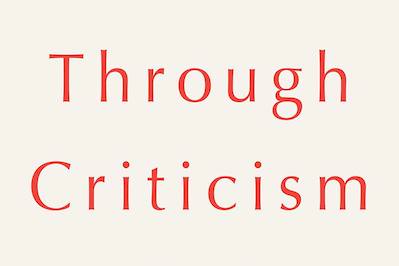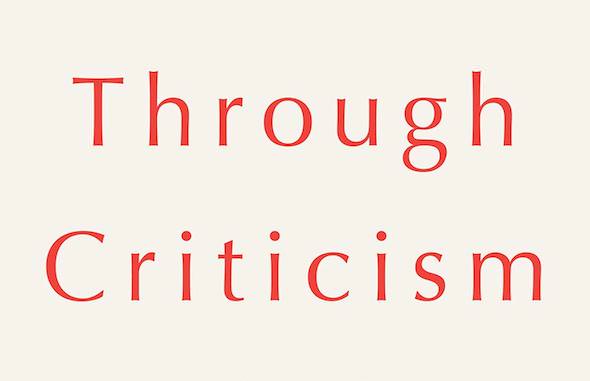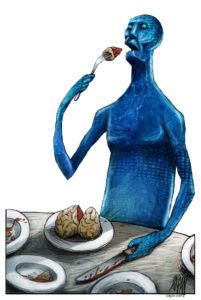Better Living Through Criticism
A new book by A.O. Scott, senior film critic for The New York Times and probably the country's most influential film critic, is a reflection on the nature of art criticism itself.

Penguin Press
|
To see long excerpts from “Better Living Through Criticism” at Google Books, click here. |
“Better Living Through Criticism: How to Think About Art, Pleasure, Beauty and Truth”
A book by A.O. Scott
A.O. Scott is the senior film critic for The New York Times, and probably the most influential and quoted film critic in the country. Yet “Better Living Through Criticism” is not, as you might expect, a collection of what he believes to be his best criticism, but a long essay on the nature of criticism itself. Since no one from Aristotle to Edmund Wilson has ever been able to justify criticism as a way to enhance life, Scott can’t be held entirely responsible for the book’s failure — the subject is simply too large to fit between covers.
Some of the text is delivered in a Q&A format that allows Scott to lob softballs to himself. Still, he fouls off many of them.
Q: But isn’t criticism what critics do?
A: Sure, and everyone who criticizes is a critic. You see the problem. We’ve barely gotten started and already we’re running in circles.
We sure are. Why not just scrap this silliness and get to the point?
Through much of “Better Living,” Scott examines the history of critical theory and, as you might expect, finds much of it wanting, which is rather a given considering that each new theory put forward by contemporary critics always trumps the ideas of the previous generation. “Nothing dates faster than artistic radicalism,” said Dwight Macdonald, to which I’d add: except perhaps radical critical theory.
Scott does approve of a passage from H.L. Mencken that argues that what motivates the critic “is no more and no less than the simple desire to function freely and beautifully, to give outward and objective form to ideas that bubble inwardly and have a fascinating lure in them, to get rid of them dramatically and make an articulate noise in the world.”
Scott applauds, “Exactly!” But, if Mencken has already made Scott’s argument for him, then my response to Scott is the same as John Travolta’s to Delroy Lindo in “Get Shorty,” when Lindo explains how easy it is to write film scripts: “Then WTF do I need you for?”
“Will it sound defensive or pretentious,” Scott writes, “if I say that criticism is an art in its own right?” It certainly does when you use those words in a rhetorical question. Why bother making grandiose claims for what criticism is or can be? There’s no doubt in my mind that recent critics such as Pauline Kael, Clive James and Greil Marcus have written criticism at least as artistic as their subjects. But I’m not aware that they wasted their time — they just wrote and let the chips fall.
Scott then returns to the question of pretention: “To call something pretentious means you are worried that you didn’t understand it.” Perhaps, but it might mean that you understood something perfectly and found it to be pretentious.
 Better Living Through Criticism
Purchase in the Truthdig Bazaar
Better Living Through Criticism
Purchase in the Truthdig Bazaar
He wastes even more time pursuing tedious and unproductive arguments about what good criticism should be. Following one such tributary, he quotes Dwight Garner, a critic more relentlessly conventional in his tastes than Scott. What is needed, Garner argues, are “excellent and authoritative and punishing critics perceptive enough to single out the voices that matter for legitimate praise, abusive enough to remind us that not everyone gets, or deserves, a gold star.”
Indeed they don’t, but the problem is not so much a dearth of tough-minded critics as a lack of places for them to write. Nearly every newspaper around the country has cut back on arts criticism, and websites such as Salon and The Daily Beast, which were once at the forefront in criticism of books, film and theater, have now turned themselves into political echo chambers or compete with entertainment sites for celebrity interviews and coverage of food and fashion.
Trying to put critical tastes into historical perspective, Scott argues that “the great falsifier of critical judgment is time.” A critic “is always at risk of committing, in the moment, what will seem to subsequent generations an inexplicable lapse in judgment. There are famous outrageous examples of this myopia — the mocking of Moby-Dick, for instance. …”
(I’m a little tired of the argument that 19th century critics weren’t smart enough to appreciate “Moby-Dick”; the proportion of critics who didn’t like the book when it was published is probably the same as those who wouldn’t get it if it were published today, no matter how hip critical theory has become.)Scott insists, “There is a logic of fallacy, a pattern of error” in critical judgments, and “For an example of how that logic works — of how a self-evidently correct judgment can mutate into its opposite, we can turn to The New York Times of March 4, 1938, and to the film critic Frank S. Nugent’s brisk four-paragraph dismissal of Bringing Up Baby, a movie that would go on to become one of the most cherished comedies of the studio era, the very quintessence of screwball.”
“Bringing Up Baby” was criticized by Nugent, who was far from alone, for Katharine Hepburn’s performance (“breathless, senseless, and terribly, terribly fatiguing”). He summarized his disdain: “If you’ve never been to the movies, Bringing Up Baby will be new to you — a zany-ridden product of the goofy farce school. But who hasn’t been to the movies?”
Nugent, Scott says, “suffered from a malady that has afflicted most of his heirs. He had seen too many movies — too many of the same kind of movies – to be able to discern the distinguishing features of individual specimens.”
I disagree on both counts. I don’t see how any critic anywhere at any time can have seen too many movies or read too many books or examined too many paintings. And I reject the idea that Nugent’s opinion is the result of some flawed historical perspective. I happen to think that his opinions are asinine, but I don’t think it was because he saw a movie in 1938, when he could not distinguish it from scores of lesser screwball comedies, instead of 1948, when Hepburn was regarded as one of the greatest actresses in films and “Bringing Up Baby” was considered a neglected masterpiece. For all we know, the critical consensus of the film in 20 or even 10 years may be closer to Nugent’s than to mine or Scott’s.
If Scott really wants to examine how flawed an opinion can appear over time, here’s a much more recent example, his own piece in the Aug. 12, 2007, New York Times on the 40th anniversary of the release of “Bonnie and Clyde.”
Scott’s article is pretty much a sustained attack not only on “Bonnie and Clyde” but also on what he believes to be its subsequent influence on American film. Though he cites and quotes Kael’s famous 9,000-word essay in The New Yorker, Scott doesn’t seem to ascribe to any of it.
“The filmmakers,” he tells us early on, “seemed less interested in the moral weight of violence than in its aesthetic impact. … As we endure another phase in the never-ending argument about movie violence — renewed by the recent popularity of extremely brutal horror films like the Saw and Hostel cycles, made momentarily acute by the Virginia Tech massacre last spring. …”
Further: “At the same time the harsh, righteous vengeance unleashed in the Dirty Harry and Death Wish movies appalled many of the same critics who dug the radical chic of Bonnie and Clyde.” I believe any critic who saw those films would certainly agree that a thinking person ought to be appalled by “Dirty Harry” and “Death Wish” and upset by “Bonnie and Clyde,” where the violence isn’t intended to produce a predictable anger or outrage but leave us unsettled.
Or does Scott really believe that the moral weight of violence is the same in every film? (Curiously, in “Better Living” he makes only one brief mention of “Bonnie and Clyde” in a couple of homages to “the great film critic Pauline Kael.”)
I don’t think it’s unfair to search for meaning in a major piece of criticism by a critic in the critic’s own book on criticism. And, frankly, it’s hard for me to imagine how any critic, especially 40 years after a film’s release, could more unfairly represent a film than Scott did “Bonnie and Clyde.”
For instance, is it possible that Scott still thinks that the film’s director, Arthur Penn, and its screenwriters, David Newman and Robert Benton, presented the violence with no other intention except to make an “aesthetic impact”? How else does Scott think that “the moral weight of violence” in any film can be presented except through aesthetics?
“Don’t misunderstand,” he wrote in 2007. “I still get a kick out of Bonnie and Clyde, but it’s accompanied by a twinge of unease, by the suspicion that, in some ways that matter and have become too easy to dismiss, Bosley Crowther [The New York Times critic who famously dismissed the film in 1967] was right.”
Crowther wrote that “Bonnie and Clyde” was “a cheap piece of bald-faced slapstick comedy.” So which is it — Scott shares Crowther’s judgment or that he still gets a “kick” out of “Bonnie and Clyde” despite it being “a cheap piece of bald-faced slapstick comedy”? Does Scott not understand that it might be precisely the point of art to leave him with some ambiguity — “a twinge of unease”?
Here, as in just about all of “Better Living Through Criticism,” we are confronted by a critic who seems afraid to trust his own instincts.
“Better Living” is soft at the center, where it needs to be harder than John Simon’s heart. Scott continually midwifes an insight and then, when he’s on the verge of it, seems afraid to commit and moves on to something else.
Which is why, ultimately and despite Scott’s intelligence and unswerving good taste, he leaves us with no lasting impression about art, pleasure, beauty and truth.
Independent journalism is under threat and overshadowed by heavily funded mainstream media.
You can help level the playing field. Become a member.
Your tax-deductible contribution keeps us digging beneath the headlines to give you thought-provoking, investigative reporting and analysis that unearths what's really happening- without compromise.
Give today to support our courageous, independent journalists.






You need to be a supporter to comment.
There are currently no responses to this article.
Be the first to respond.